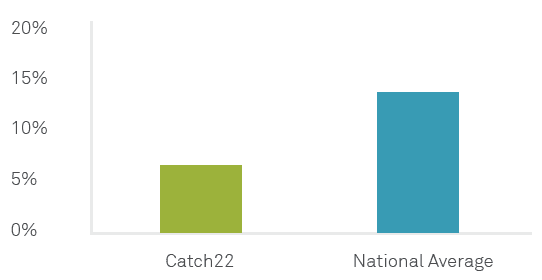Catch22 is a not-for-profit business with a social mission. We exist to deliver public services that change people’s lives. We are made up of over 1000 people from all over the country, brought together by common values. We reflect the communities we work in. We believe that diversity makes us stronger.
We’re a diverse bunch, and all the better for it. But there’s one thing that runs through us all, a belief that people can thrive if they have a good place to live, good people around them and a clear purpose in life.
We design and deliver services that build resilience and aspiration in people of all ages and within communities across the UK. We operate in three main hubs: Justice and Education, Employability and Skills, and Young People, Families and Communities building these skills in the people we support.
- The Catch22 family has touched the lives of more than 160,000 people in the last year.
- 100% of commissioners were satisfied with the service provided across our young people and families provision.
- In Justice, we worked with 12,000 victims and witnesses of crime.
- 82% of GCSEs were achieved in our alternative education schools.
In line with government regulations, Catch22 publishes its gender pay report annually. As well as setting out the data, the report also provides an opportunity for us to confirm our commitment to improving the gender balance of our workforce and explaining the actions we are taking to achieve this. We value our people and want them all to be confident that they have a great place to work, where they are able to fulfil their potential.
Definitions
What is the gender pay gap and why is it important?: The gender pay gap is defined as the relative difference in the average earnings of women and men. This is reported by looking at the mean and the median pay gap between males and females.
What is the mean pay gap?: The mean is calculated by adding the salaries of all the relevant employees and dividing the figure by the number of employees.
What is the median pay gap?: The median figure falls in the middle of a range when the salaries of all relevant employees are lined up from smallest to largest.
Gender pay is different to equal pay. At Catch22, women and men receive equal pay for equal work. This is an absolute minimum standard for a forward-thinking social business such as ours and we continually review our hiring and compensation practices to ensure this remains the case.
We hold ourselves accountable because this matters to us. At Catch22 our aim is to eradicate the median gender pay gap within the next five years. We are committed to ensuring that every one of our colleagues has an equal opportunity within the workplace regardless of their gender
For our 2022/2023 gender pay report we had a total of 770 employees included in the report. 546 employees identify as female, and 224 identify as male.
- In Catch22, our mean gender pay gap is 10.14%.
- In Catch22, our median gender pay gap is 6.18%.
This is a 2.4% reduction from last year. We are making progress to reduce our gender pay gap, by providing a welcoming and flexible environment for our people and actively working to increase the percentage of females who work in senior roles across the organisation.
We are proud to have a diverse workforce and will look to ensure that in each quartile our workforce demographic is representative of the people we support. We believe by achieving this we will reduce our gender pay gap and demonstrate our commitment to building an inclusive and diverse community.
We are also pleased that our gender pay gap remains below national average but we are committed to ensuring that our gender pay gap reduces and is completely eradicated within 5 years:

Progress
Since 2017 we have made progress with increasing the number of women in our top two pay quartiles, to make these more reflective of our overall demographic. We have continued to make progress in increasing the number of females in our upper quartile. This year it increased from 62.1% to 64%.
Pay distribution |
% female |
% male |
| Lower Quartile (lowest paid) | 72% | 28% |
| Lower Middle Quartile | 74% | 26% |
| Upper Middle Quartile | 73.5% | 26.5% |
| Upper Quartile (highest paid) | 64% | 36% |
We are pleased to report that we do not have a bonus pay gap as women earn £1 for every £1 that men earn when comparing median bonus pay. Their median bonus pay is 0% lower than men’s.
- In Catch22, women earn 94p for every £1 that men earn when comparing median hourly pay. Their median hourly pay is 6.2% lower than men’s.
- In Catch22, women earn £1 for every £1 that men earn when comparing median bonus pay. Their median hourly pay is equal to men’s.
Moving forward, more focus will be given to the following initiatives:
- Review and analyse the data to identify specific jobs with wide median pay gap differentials.
- Review of our pay and grading structure, specifically looking at progression.
- We will continue to make a conscious effort to improve our gender balance by broadening our attraction strategy and ensuring we have diverse candidate short lists for all leadership roles.
- Utilise a non judgemental job evaluation to evaluate all job roles.
- Review the way we recruit to ensure hiring managers are skilled in non-gender bias.
- Review the gender pay gap data, on a biannual basis to analyse and monitor trends.
- Continue to promote flexible working practices across all roles within the organisation.



